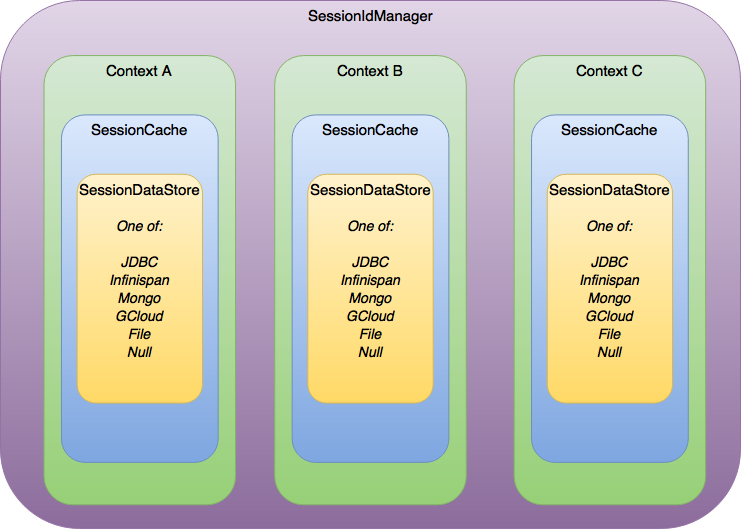
Version: 9.4.5.v20170502
 Version: 9.4.5.v20170502 |
private support for your internal/customer projects ... custom extensions and distributions ... versioned snapshots for indefinite support ... scalability guidance for your apps and Ajax/Comet projects ... development services for sponsored feature development
Table of Contents
Sessions are a concept within the Servlet api which allow requests to store and retrieve information across the time a user spends in an application. Choosing the correct session manager implementation is an important consideration for every application as each can fit and perform optimally in different situations. If you need a simple in-memory session manager that can persist to disk then session management using the local file system can be a good place to start. If you need a session manager that can work in a clustered scenario with multiple instances of Jetty, then the JDBC session manager can be an excellent option. Jetty also offers more niche session managers that leverage backends such as MongoDB, Inifinispan, or even Google’s Cloud Data Store.
The architecture of Session Management Jetty changed significantly in Jetty 9.4. These changes have resulted in Sessions not only being easier to configure but making them much more pluggable for various technologies.
In previous versions of Jetty, users were required to configure a separate SessionIdManager for each kind of session clustering technology being implemented (JDBC, MongoDB..etc.).
In Jetty 9.4, there is now a single SessionIdManager implementation which works across all types of session clustering technologies.
Likewise, prior to Jetty 9.4 there were several different instances of the SessionManager class.
Instead of a single SessionManager though, it has been done away with entirely, with most of it’s functionality moved to the SesssionHandler class.
Additionally, Jetty 9.4 introduced the concepts of a SessionCache and an associated SessionDataStore (both explained below).
Finally, Session scavenging has been re-worked.
Where previously each SessionManager instance would periodically scan the in-memory (or clustered) sessions for expired sessions, there is now a single generic scavenger thread which instructs the SessionHandler to clean up expired sessions.
Session expiration has been changed to use a much more efficient timer-based mechanism that avoids constant iteration over all current sessions in memory by the scavenger.
Each Jetty instance has a singular SessionIdManager to handle all session requests, regardless of clustering technology.
For each context on the server there is one (1) SessionCache which contains all of the Session objects for the given context.
The benefit of the SessionCache is to ensure that simultaneous requests accessing the same Session Id in the same context always operate on the same Session object.
The SessionCache implementation supplied with the Jetty distribution does just that: keeps Session objects in memory so that they can be shared between simultaneous requests.
However, it is possible to provide your own implementation that never shares Session objects should you require it.
Where the SessionCache handles Session information, Session data is stored in a SessionDataStore that is specific to the clustering technology being implemented.
There is only one (1) SessionDataStore per SessionCache.
Visually the session architecture can be represented like this:

Jetty provides support for several different Session Management technologies. Both local file storage and in-memory session management can be implemented for standard implementations. For implementations using clustered technologies, JDBC, MongoDB, Inifinispan and Google Cloud Datastore are all supported. Setting up these technologies is as easy as enabling it’s module and editing it’s associated ini file with any usernames, passwords or changes you need to make for your instance. The following sections will cover how exactly to enable the required modules as well as an overview of what options are available for customization.